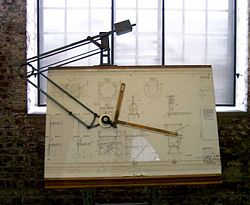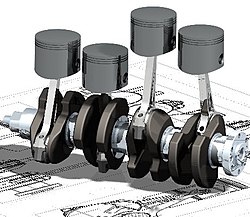Technical drawing
Technical drawing, also known as drafting or draughting, is the act and discipline of making detailed drawings. These drawings visually communicate how something works or how it is to be made.
Communicating ideas
Technical drawing is essential for communicating ideas in industry and engineering.[1]
To make drawings easier to understand, people use familiar symbols. They use standard units of measurement, notation systems, visual styles, and page layouts. These drawing conventions are internationally accepted standards. Technical drawings are a universal way of communicating complex mechanical concepts. Technical drawing are very different from the expressive drawing of the visual arts. Artistic drawings may have many meanings. Technical drawings are understood to have one intended meaning.[2]
Technical drawings are used to make electronic parts as well as mechanical parts.[3] They are used in commercial and residential construction. Roads, bridges, and wastewater systems are just some of the things that need technical drawings. Almost anything that is manufactured requires technical drawings.[3]
Technicians
A drafter, draftsperson, or draughtsman is a person trained to make technical drawings. A professional drafter who makes technical drawings is sometimes called a drafting technician. Professional draftspersons bridge the gap between engineers and manufacturers. They contribute experience and technical expertise to the design process.
Technical Drawing Media
Sketch for a government building
An example of a drawing drafted in AutoCAD
View of a CAD model of a four-cylinder inline crankshaft with pistons
To plan a renovation, this architect takes measurements he will later enter into his computer-aided design system.
Engineering drawing of a machine tool part
Related pages
References
| Wikimedia Commons has media related to Lua error in Module:Commons_link at line 62: attempt to index field 'wikibase' (a nil value).. |
- ↑ "Engineering Drawing and Sketching". The University of Minnesota. Retrieved 18 April 2015.
- ↑ Goetsch, David L.; Chalk, William S.; Nelson, John A. (2000). Technical Drawing. Delmar Technical Graphics Series (Fourth ed.). Albany: Delmar Learning. p. 3. ISBN 978-0-7668-0531-6. OCLC 39756434.
- ↑ 3.0 3.1 Antonio Ramirez; Jana Schmidt; Douglas Smith, Technical Drawing 101 with AutoCAD 2015 (Mission, KS: SDC Publications, 2014), p. 3
Other websites
- Technical Drawing Archived 2015-03-15 at the Wayback Machine
- Technical Drawing Tutorial









